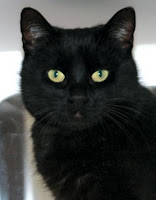 |
| Nelson needs a Hospice Home |
Over time, "hospice" came to refer to places of hospitality for the sick, wounded, dying, and travelers and pilgrims.
The modern concept of hospice, which includes palliative care, was pioneered in the 1950s. Palliate comes from the Latin "palliare," meaning "to cloak," as in cloaking pain without curing the underlying medical condition.
Dame Cicely Saunders, a British physician, is credited with developing the modern hospice model. Saunders was inspired by David Tasma, a patient hospitalized with an inoperable cancer. They met in 1948 and envisioned a place better suited to prepare for death than a busy hospital ward.
When Tasma died, he bequeathed £500 to Saunders. In 1967, she used the funds to open St. Christopher's Hospice and launch the modern hospice movement. Although the concept met with some resistance, it has since expanded rapidly around the world.
What, you might ask, has any of this to do with the Yavapai Humane Society (YHS)?
YHS is at the vanguard of a movement whose trajectory has largely paralleled the modern hospice movement. I'm referring to the no-kill movement.
The human "hospice movement" and the animal "no-kill movement" were born in the late 1960s and early 1970s respectively and share a deep respect for the sanctity and dignity of life. It seems only natural, albeit in retrospect, that the two movements would at some point meet.
Renowned English journalist Malcolm Muggeridge, perhaps without intending to, helped put these life-affirming movements into context when he said, "life, however low it flickers or fiercely burns, is still a divine flame which no man dare presume to put out; either life is always and in all circumstances sacred, or intrinsically of no account; it is inconceivable that it should be in some cases the one, and in some the other."
The Yavapai Humane Society embodies the ethic that all life is sacred and believes homeless pets ought not to be killed simply because of a lack of space, resources or out of convenience. This ethic leads to taking responsibility, rather than excusing problems and hiding consequences. Since implementing the no-kill ethic in July 2010, YHS has achieved an 80 percent decline in killing and a 96 percent Live Release Rate in 2012. That means 96 percent of the animals rescued by YHS are placed into loving homes; compared to a national shelter average of just 50 percent.
The animals who don't fare so well are those who come to us suffering from a disease, injury, or congenital or hereditary condition that is likely to adversely affect their health in the future. Animal shelters almost universally support euthanasia for these animals. It is for them that YHS is launching its own hospice program.
If you love animals and can find it in your heart to open your home to provide short-term hospice care to these worthy animals, please enroll in this life-affirming program. YHS will provide and support you with all the medical care the animal will need, including euthanasia when the time comes. All you need to provide is food (which we can help with), water, shelter and love. If interested, call 445-2666, ext. 21, for more information.
Nelson, the cat in the picture, is in need of a Hospice home. He is a 7-year-old neutered Persian diagnosed with inflammatory bowel disease. He is on antibiotics, prednisone, an intestinal prescription diet and intestinal medication. His condition is manageable; however, his prognosis is poor. His condition progresses at varying rates and in time will not respond to medical management. He is comfortable and happy for now and needs a hospice home where he can be given medication, brought into YHS for checks-ups and monitored until his condition is no longer manageable. Call 445-2666, ext. 21, for more information.
Ed Boks is the executive director of the Yavapai Humane Society. He can be reached at eboks@yavapaihumane.org or by calling 445-2666, ext. 21.





